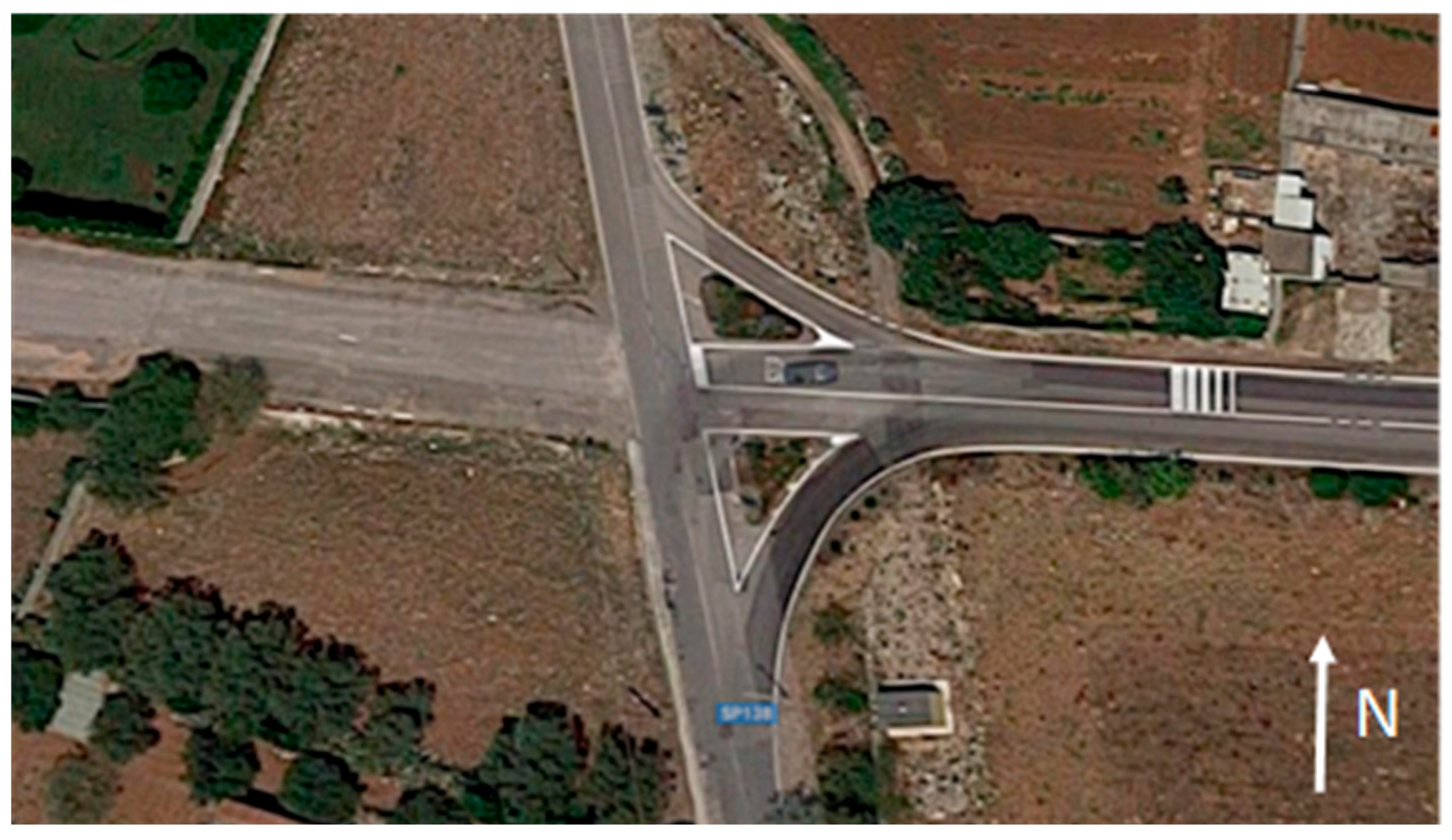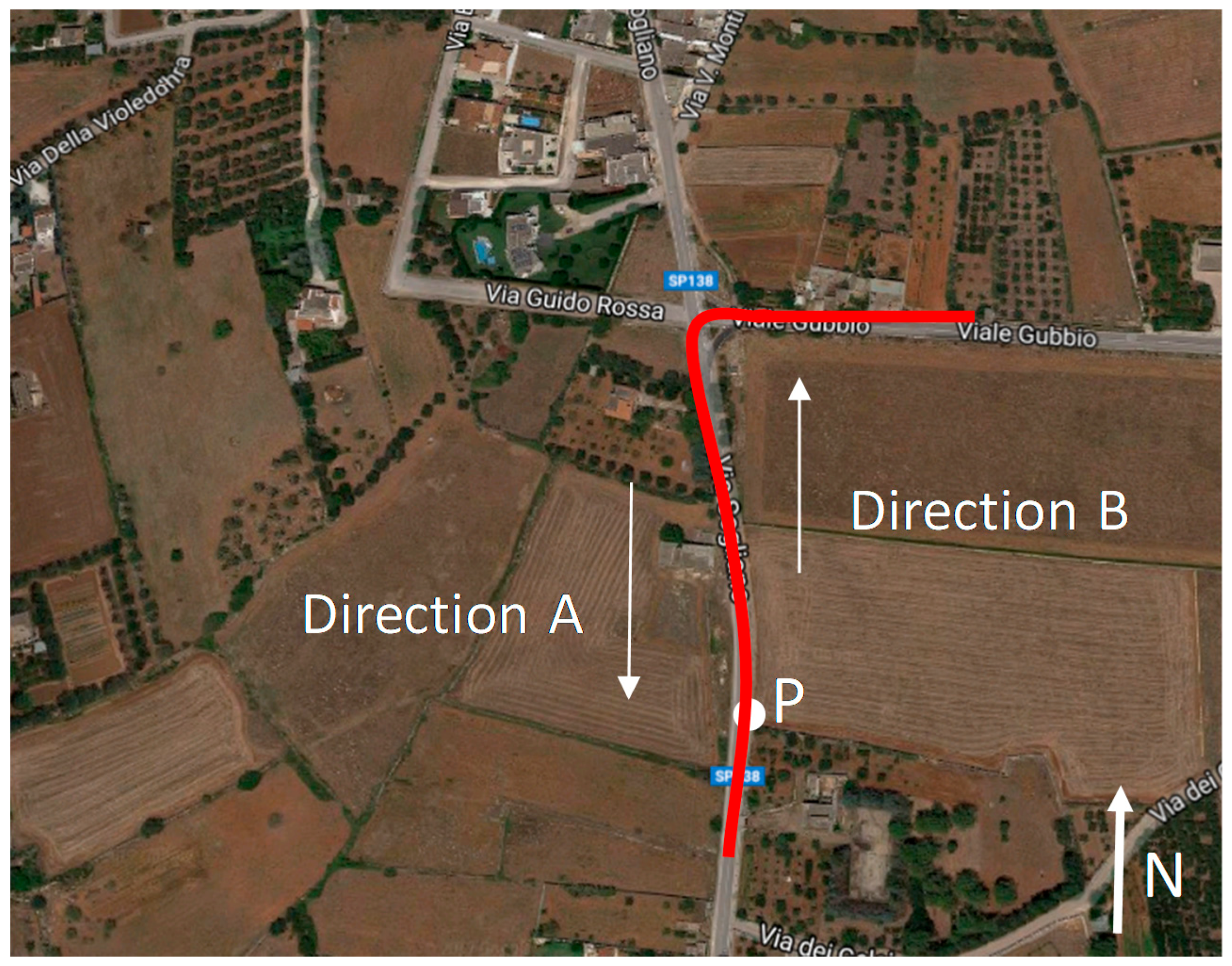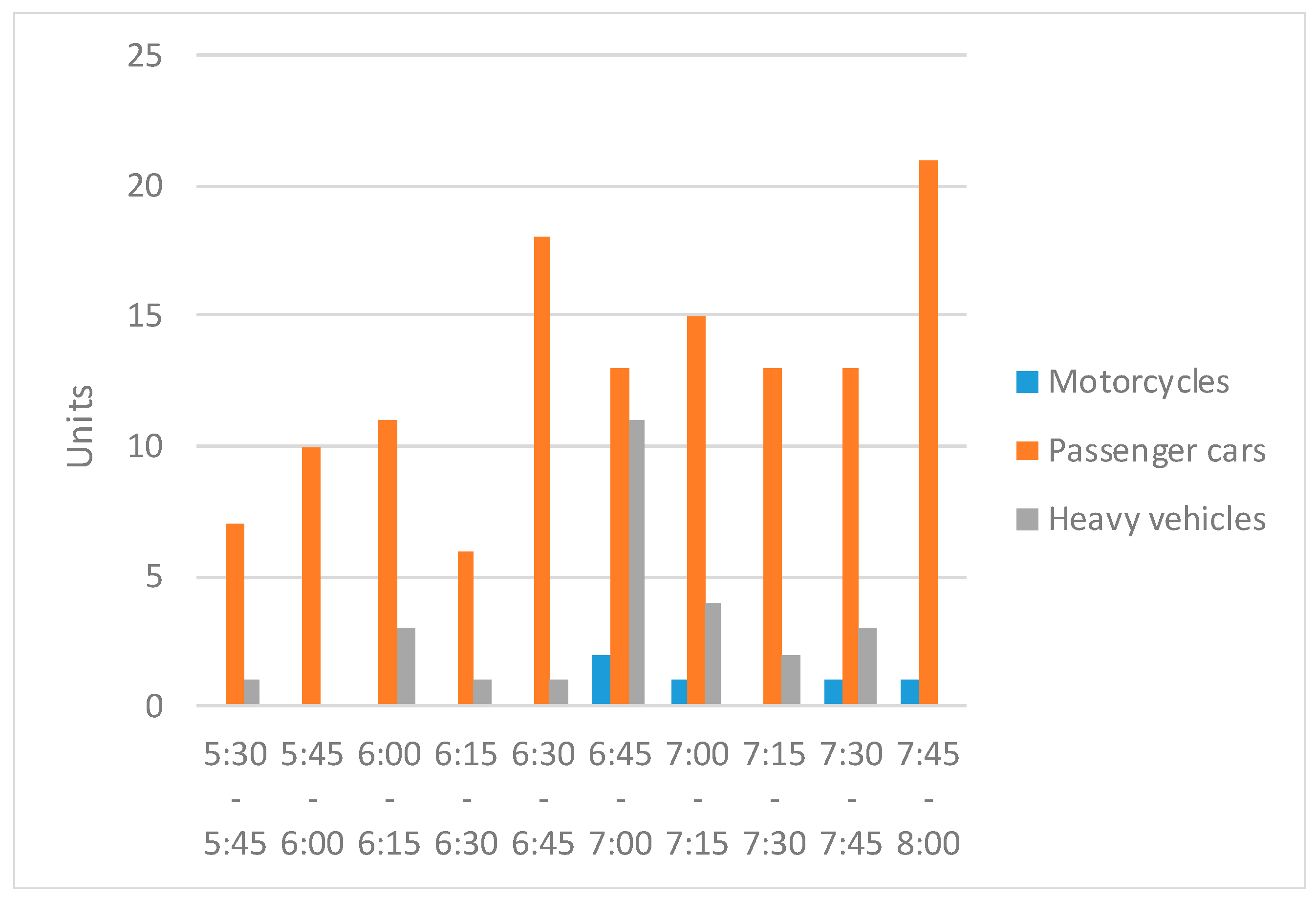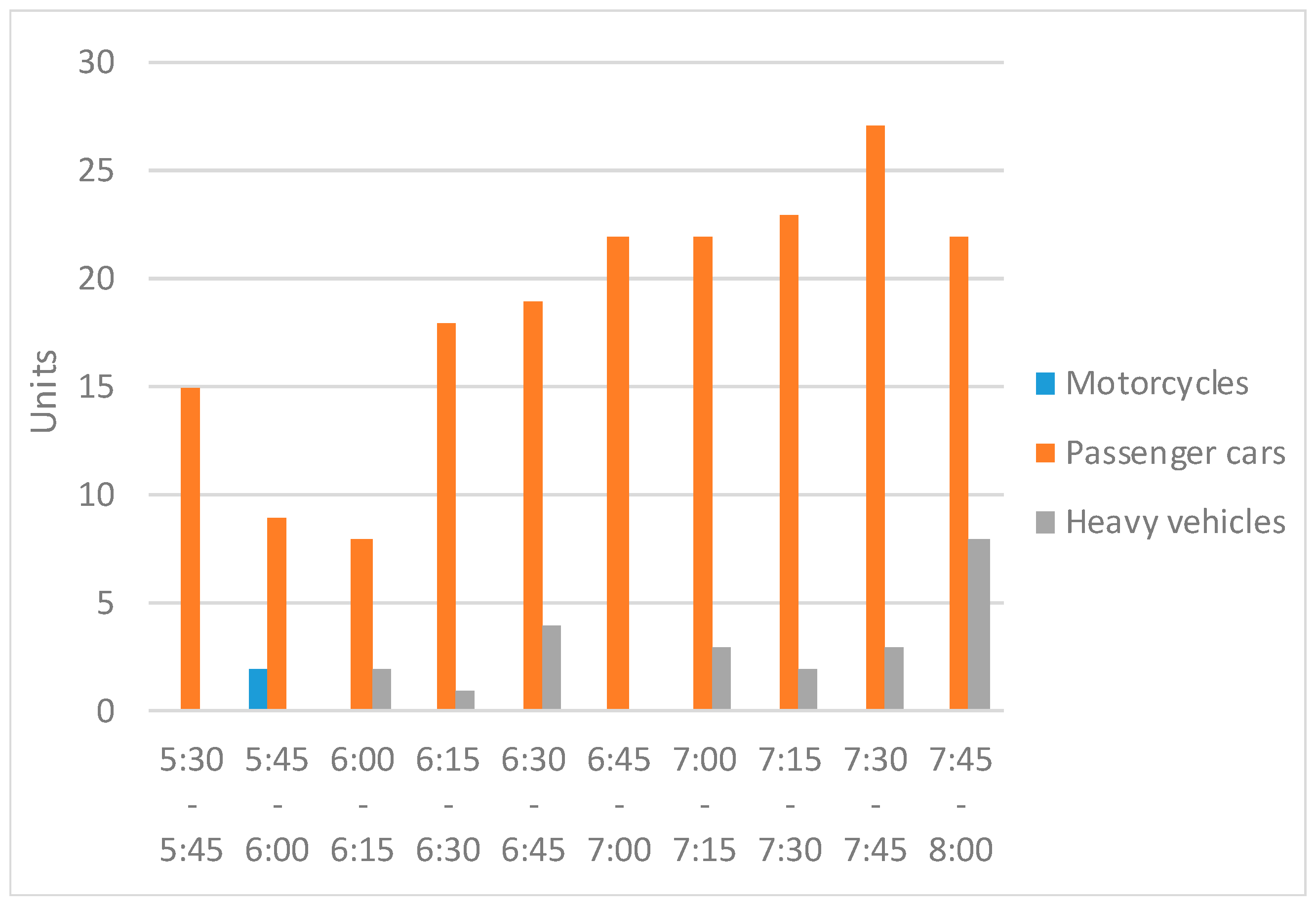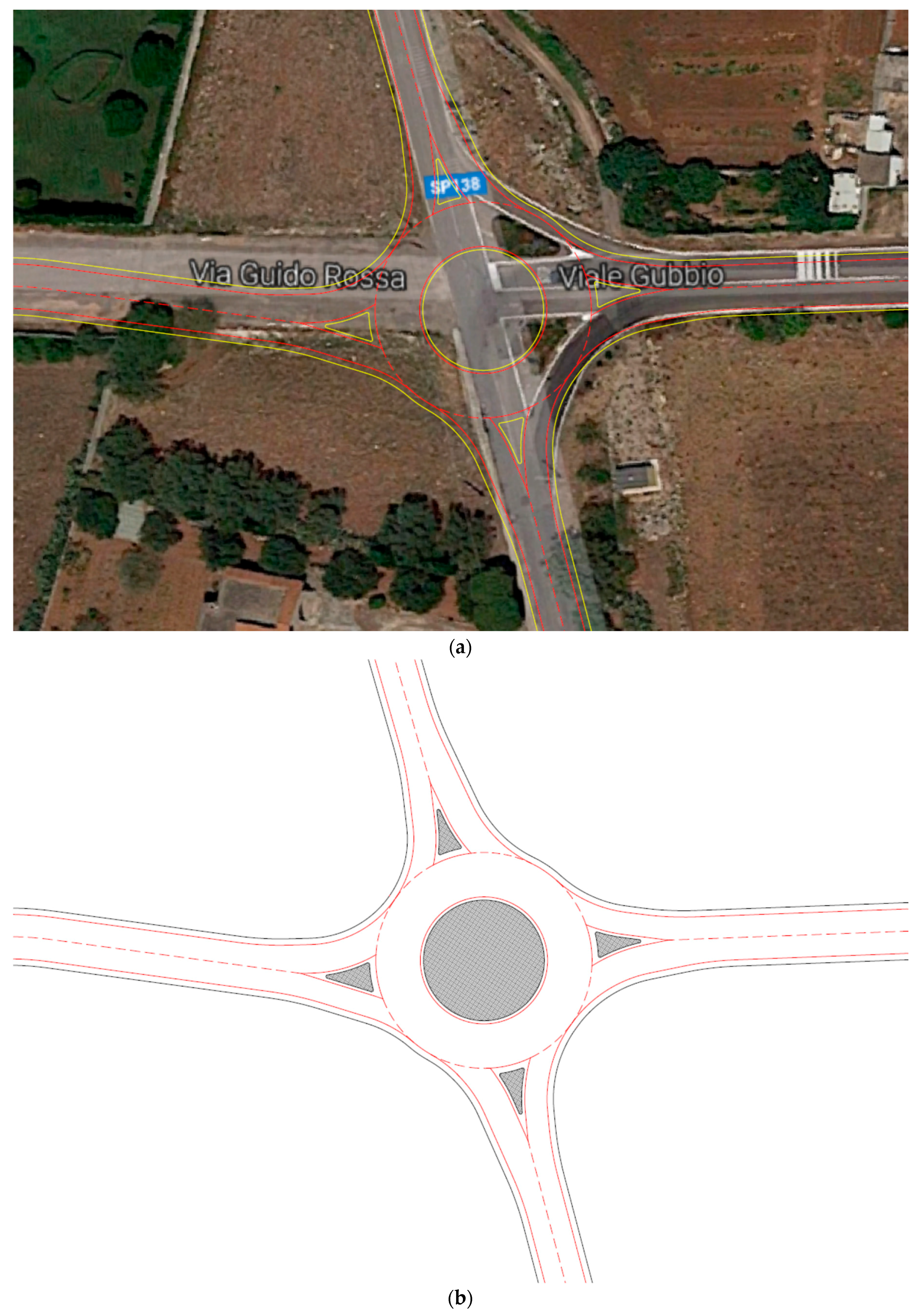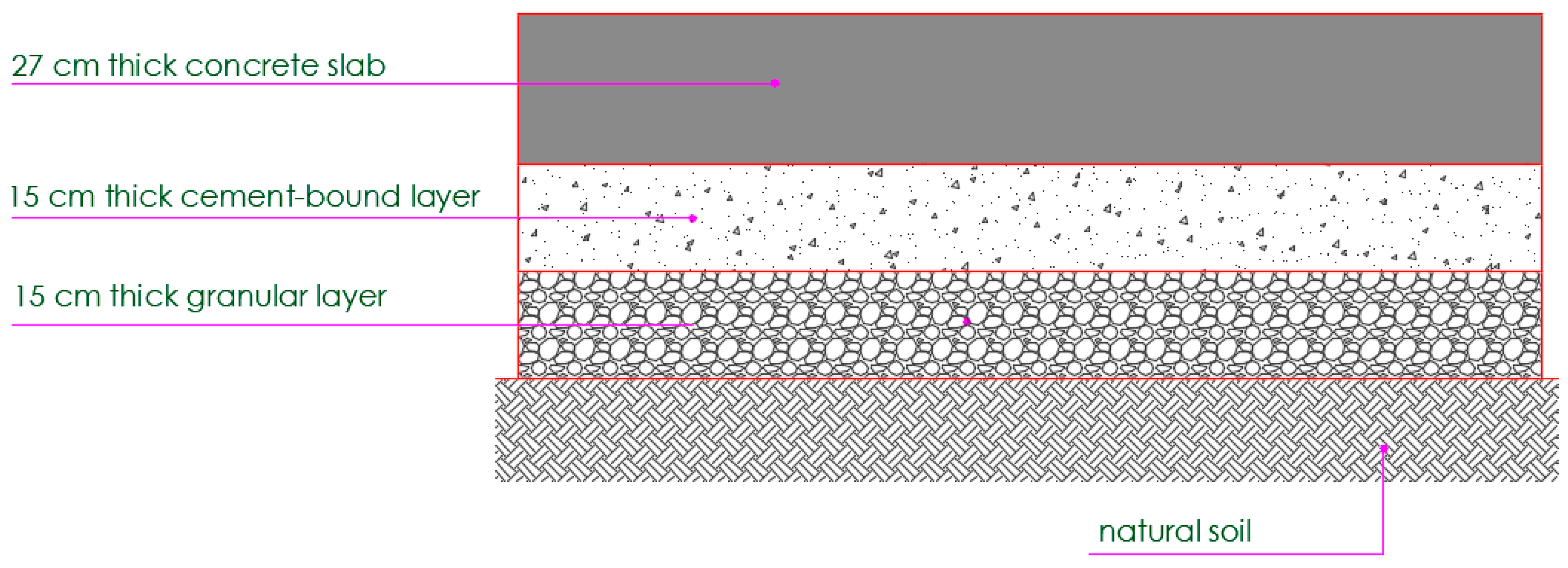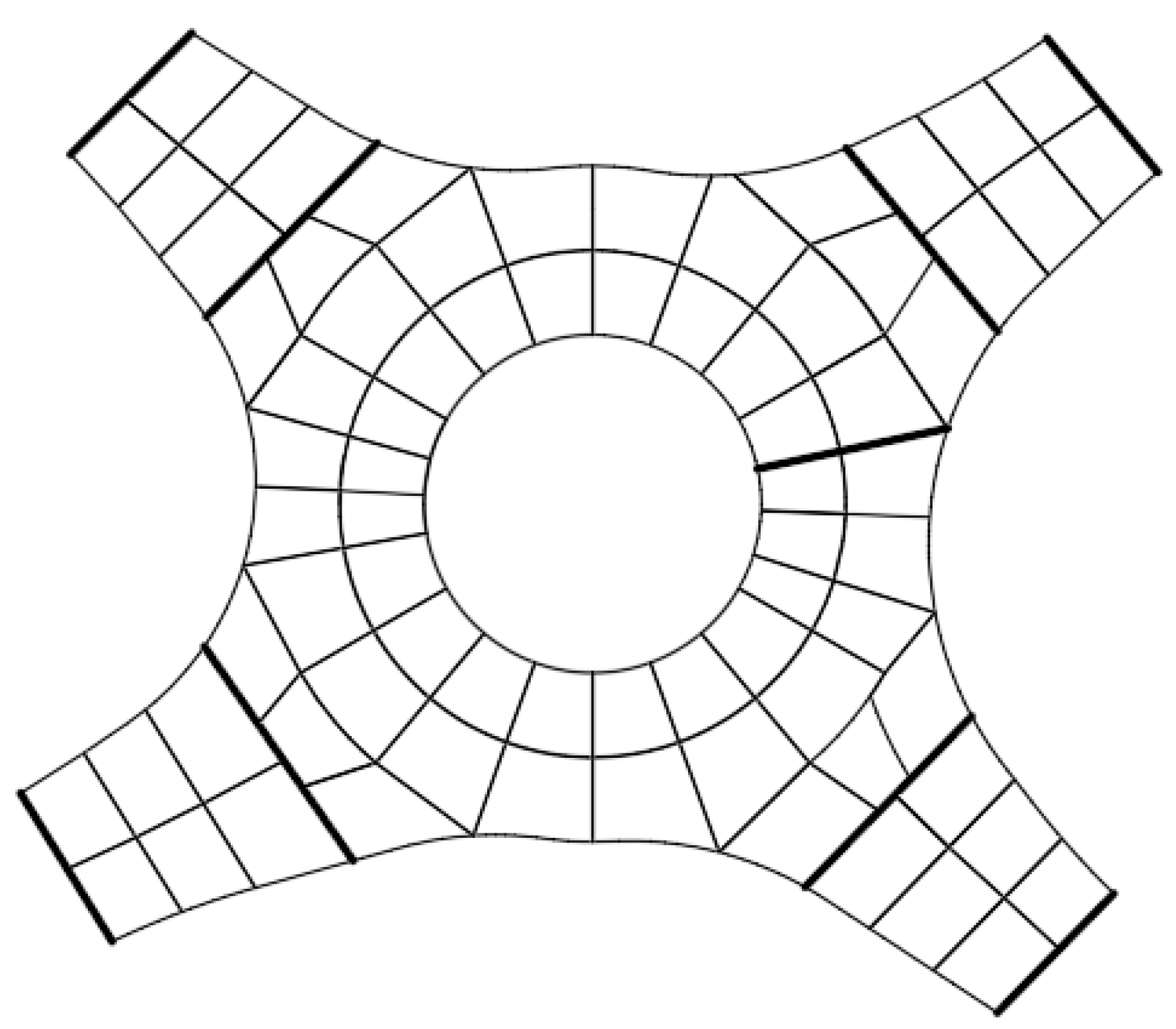1. Introduction
Roundabout is a road junction composed of an unsurmountable central island, around which vehicles circulate counter-clockwise in the Countries where the regulation is right-hand traffic. The solution enables the collection and distribution of all vehicles that access and egress the intersection, from the different arms, on the same trajectory.
Roundabouts are usually built to increase traffic fluidity or to manage and slow down fast vehicular flow [
1]. In the first case they can be located at intersections with high traffic volumes; in the second case they replace quiet residential junctions, in the form of miniroundabouts, to make intersections safer for pedestrians, and vulnerable users in general [
2,
3,
4]. The roundabouts can as well cut down vehicular emissions and fuel consumption by reducing the vehicle idle time at intersections and thereby creating a positive impact on the environment [
5,
6,
7].
A remarkable advantage of roundabouts is increasing safety for vehicles using the intersection by reducing the fatal crashes and all crashes by a significant percentage [
8,
9]. In the USA a study on 23 intersections estimated highly significant reductions of 40% for all crash severities combined and 80% for all injury crashes [
10]. Similar reductions were found in some studied performed all over Europe [
11,
12].
The design process of a roundabout requires the definition of its geometric characteristics according to the expected traffic demand and the layouts defined by the reference standards. There are many ways to classify a roundabout: according to the yield pattern, its approach lanes, design speed, etc.
The typology proposed by the U.S. Federal Highway Administration (FHWA) [
13] is maybe the most complete, since it is based on the statement that “a roundabout is a type of a circular intersection, but not all circular intersections can be classified as roundabouts”. FHWA detects the following types of circular intersection:
Roundabouts: circular intersections with specific features as yield control of entering traffic, channelized approaches, appropriate geometric curvature;
Rotaries: old-style circular intersections, typical of USA roads up to the ’60 s, with a large diameter (even > 100 m), and where circulating traffic yields to entering traffic;
Signalized traffic circle: old-style circular intersections, used in some cities of the USA where traffic signals are used to control one or more entry-circulating point.
Neighborhood traffic circles at intersections of local streets for traffic calming or “aesthetics” reasons.
FHWA separates the roundabouts into three basic categories according to size and number of lanes:
- (1)
Mini roundabouts: small roundabouts in low speed urban areas with average operating speed of 50 km/h or less, useful in environments with right of way constraints or with insufficient right of way for compact roundabouts
- (2)
Single-lane roundabouts: they have a single lane entry at all arms and around the central island, they have larger inscribed circle diameters than the mini roundabout and non-traversable central area; higher vehicular capacity and consistent entering and exiting speeds (30 to 40 km/h) are important features of this kind of roundabout.
- (3)
Multilane roundabouts: they are characterized by two or more entry lanes at least on one approach with an entry speed of 40–50 km/h and by wider circulatory roadways.
In 1997, the Roundabouts Swiss Guide [
14], considered three types of roundabout, according to size, to environment of application and to limitations of maneuvers: big roundabouts, compact roundabouts, and mini roundabouts (with semi/fully mountable island). But later on, according to Swiss Standard SN 640263 [
15], roundabouts were classified into just two categories, according to their external diameter and configuration: the compact ones (for high traffic environments, external diameter between 26 and 40 m, not mountable central island) and the mini ones (for local traffic, external diameter between 14 and 26 m, mountable or semi mountable central island). Mini roundabouts are recommended to be avoided in case of high pedestrian traffic.
CERTU’s (Centre d’études sur les réseaux, les transports, l’urbanisme et les constructions publiques) French recommendations are basically in accordance to what stated in the Swiss regulation (big/compact and mini roundabouts) with slight differences for what concerns the related size [
16]; also, in this case, pedestrian crossings are recommended on the arms, taking care to locate them at a suitable distance from the “give the right” sign (not farther than 2–5 m).
Italian standards on roundabouts define three kinds of roundabouts [
17]:
the so-called “conventional” ones (i.e., big roundabouts with arms with the same width up to the accessing point), with an external diameter between 40 and 50 m;
the compact ones (with a smaller diameter in comparison to the conventional ones and with arms with enlargements at the accessing points) with an external diameter between 25 and 40 m;
the mini roundabouts, with an external diameter between 14 and 25 m.
The same approach can be found in standards from other countries; in Norway, for instance, classification pattern is very similar to the other European cases, assuming as main criteria the diameter of the central island and the inscribed circle diameter [
18]. They lead to classify roundabouts into large, medium, small and mini [
19,
20,
21].
The geometrical design of the roundabout here presented is compliant with the Italian standard, as requested by the local government of the region in which the junction is located. At any rate, they are very similar to those required in other countries.
Table 1 summarizes the main characteristics of roundabouts according to Italian standards.
Even if the geometrical details of the roundabout are defined according to the national standards, the dimensions (truck apron, roadway widths, curvature, etc.) are generally verified by a swept path analysis. Many studies are available on this subject [
22,
23,
24], generally performed by means of specialist software. In this case, the design of the roundabout has been verified graphically conducting the swept path analysis according to the constant pursuit method [
25]. The design vehicle was a tractor trailer 2.2 m wide and 16 m long with 4 axles.
The type and the sizes of the roundabouts vary according to vehicles flow, even when, as in the case of mini roundabouts, they can be implemented in sites where pedestrian traffic can become dominant.
In conclusion, roundabouts differ from other circular intersections because of the following features: traffic control (yield control on all entries); priority to circulating vehicles (they have the right-of-way); pedestrian accesses (only across the arms of the roundabouts); no parking allowed; counter-clockwise circulation on the ring [
26]. On the contrary, stop control or no control at all can occur on traffic circles, circulating traffic can be required to yield to entering traffic, pedestrians can cross through to access to the central island, parking can be allowed.
The aim of this paper is to present the overall design process of a compact roundabout to be built in the Southern Italy, in the Municipality of Soleto. The roundabout will be the first one in Italy with a jointed plain concrete pavement, and will serve heavy traffic from and to a cement factory. The choice of a concrete pavement is justified by the lower maintenance required than an equivalent bituminous pavement [
27,
28]. The proposed study involves traffic analysis, geometric design of the intersection, calculation of the pavement thickness, design of joint layout, and laboratory tests to define the concrete mix. The importance of this work is that it provides information about the whole process needed to transform an existent ordinary four-arm junction into a compact roundabout, according to the regulatory reference above-mentioned. The value of these analyses is that the results are useful to identify and improve processes and technologies currently used in this field in order to optimize traffic performance at intersections.
2. Design Process
The intersection to re-design is represented in
Figure 1; currently, it is an ordinary grade four-arm junction.
In the last years, there was an increase of accidents on the North-South alignment [
29] due to:
the high speed induced by the road planimetric alignment (i.e., straight and horizontal slope);
the incorrect perception of the transition between the rural and urban context (the urban environment starts at the intersection).
In addition, due to high levels of heavy traffic running on the intersection, the local authority decided to convert it into a medium compact roundabout as a traffic calming solution [
30].
Also, from the economic point of view, a roundabout represents a good solution: in a previous study [
7] two separate economic analyses were developed to compare a roundabout and an intersection at grade: the first on fuel consumption, and the second including also the average delay experienced by users. The analyses highlighted that after few years (less than five), the construction costs spent in roundabouts are refunded, for the common good, by benefits on users [
31].
The design of the intersection consists of the following steps:
traffic analysis;
design of geometric layout of the roundabout;
design of the thickness pavement;
design of the joint layout;
mix design of concrete.
2.1. Traffic Analysis
This type of traffic requires specific and accurate analyses of the traffic demand to serve, which affects the design of the appropriate geometric and structural features, and its control, to ensure regular and safe flows at road intersections. The demand analysis required a survey of traffic flows, to collect data on traffic volume and components. Each type of vehicle surveyed was classified by means of a traffic monitoring system. Traffic was surveyed for longer periods in the daytime. Monitoring (point P in
Figure 2) involved both directions of the busiest arm, thus highlighting where highest traffic flows can be located (red in
Figure 2).
Table 2 reports data collected during early morning time.
The observed traffic volume of the vehicles from all the arms does not exceed 500 vehicles/h, therefore according to Brilon [
32] there is no need for evaluation of traffic capacity of the one-lane roundabout.
The analysis of traffic composition highlighted that volume of motorcycles is negligible, whereas heavy vehicles account for an average 15% of the total volume of passenger cars and heavy vehicles (
Figure 3 and
Figure 4). More specifically, heavy vehicles were 21% and 12% of total traffic respectively for directions A and B represented in
Figure 2.
2.2. Geometric Layout of the Roundabout
The survey reported flows of single unit or single trailer trucks, which required the study of their swept path envelopes, the larger of which due to 18 m long and 2.55 m wide vehicles. Moreover, the geometric configuration of the current junction and its comparison with the project (
Figure 5a), its surrounding not-built area were additional constraints considered to design the counterclockwise roundabout (
Figure 5b), according to the Italian standard for road intersection design [
17].
According to the Italian standards for road intersection, the geometric requirements to be met by the following design criteria were [
17]:
for each arm, deviation angle ≥45°;
number of entry lanes = 1;
approach width lane equal to 3.5 m;
exit width lane equal to 4.5 m;
number of circulating lanes = 1;
circulating road width composed of the lane and the lateral shoulders equal to 8.5 m;
unsurmountable central island.
2.3. Thickness of Road Pavement
Meeting all the above requirements enables to accommodate any type of vehicles, according to the survey information. They have load limits of 44 t with no more than 5 axles with a maximum axle weight limit of 12 t (
Table 3). 9 heavy vehicle types have been considered, they have single (S), tandem, or tridem axles with single (s) or twin (t) wheels [
33].
The flows of the different types of heavy vehicles in percentage (
Table 2), the yearly traffic volume and the service life have been considered as design inputs for designing road pavement. The yearly traffic volume and the service life were considered as inputs to design the road pavement. Data collected during the traffic surveys (partially shown in
Figure 3 and
Figure 4) allowed the estimation of the cumulated yearly traffic level. To this aim peak time values determined the design-hourly volume (
DHV). For the direction A,
DHV is equal to 26 heavy vehicles in 2.5 h. As more than 95% of traffic volume at the junction is generated by the nearby cement plant, the following referencing parameters were considered for the calculation of the Total number of Yearly Passages (
TYP):
12 h a day (H);
6 days a week (D);
47 weeks per year (W),
Thus resulting in Equation (1):
Therefore, at the end of project life of 20 years, the number of commercial vehicle passages is 700,000 (Equation (2)), assuming equal to 0 the traffic growth rate. Such assumption relies on the forecast of no changes in the cement plant operations, nor in the local land use, which enables to forecast:
where
Table 4 shows the total number of passages of each vehicle type listed in
Table 2.
A Jointed Plain Concrete Pavement (JPCP) has been then designed: it is the first experience of road concrete pavement in Italy for a roundabout. Therefore, it represents an important novelty in a State where road concrete pavements are not currently used in nigh on 30 years [
34] and only recently JPCPs are used to pave road tunnels [
35] due to their technical and economic advantages if compared to asphalt pavements [
36,
37].
This type of pavement has a high strength to the tangential stresses that the heavy traffic produces during its motion along the curve. In addition, the pavement of this roundabout is subjected to a high traffic volume at low speed that can produce high level of rutting in materials like the asphalt concrete [
38].
These are the main reasons for the choice of concrete pavements: recent studies demonstrated the economic convenience on the life cycle of rigid pavements compared to asphalt pavements when maintenance costs are considered [
27].
The thickness design of JPCP was designed with the Westergaard theory, which permits to calculate the stresses induced in the slabs by traffic loads [
39].
This rational theory gives theoretical closed-form solutions for concrete slabs. They are based on the theory of thin slabs, with the slab’s transverse dimension, or thickness, small if compared to the length and width dimensions. A fatigue verification of concrete has been calculated according to the Miner’s law (Equation (3)).
where
n is the number of load repetitions during the design life and
N is the number of allowable load repetitions.
N was calculated with the experimental law proposed by Sawan–Darter (Equation (4)) [
33]
Finally, the pavement has been verified according to the AASHTO (American Association of State Highway and Transportation Officials) Guide method [
40].
The AASHTO method is based on the comparison between the forecast number of repetition of traffic loads (N18) over the pavement life and the performance of pavement layers (W18). Both N18 and W18 are calculated considering an Equivalent Single Axle Load (ESAL) whose weight is 81.6 kN.
For each axle listed in
Table 2,
W18 has been calculated according to Equation (5).
where
ZR is the standard normal deviate,
So is the combined standard error of the traffic prediction and performance prediction;
D is the slab thickness;
ΔPSI is the difference between the initial and final
PSI, which measures the ability of the pavement to serve the design traffic;
S’c is the modulus of rupture of concrete;
J is the load transfer efficiency between adjacent slabs;
Cd is the drainage coefficient;
Ec is the Young modulus of concrete;
K is the subgrade modulus of reaction.
Table 5 lists the values of variables of Equation (5).
By applying data from
Table 4,
W18 is equal to 2.64 million.
The expected ESAL
N18 is the sum of the ESALs (
Nx) calculated for each combination of load, axle, and wheel (
x) listed in
Table 2. Equation (6) allowed the calculation:
where
Lx is the load on one single axle, one set of tandem axles or one set of tridem axles;
L2 depends on the axle type (1 for single axle, 2 for tandem axles, 3 for tridem axles);
Gt and
βx are respectively calculated according to Equations (7) and (8).
Table 6 lists the data for calculation of
N18: the sum of values listed in column
N18,x is equal to
N18.
N18 is equal to 1.61. Therefore, the condition in Equation (9):
is satisfied and the pavement is verified.
In conclusion, the concrete pavement of the circulatory roadway is composed of un-dowelled 27 cm thick concrete slabs cast in situ over a 15-cm thick cement bound layer and 15 cm thick granular layer.
Figure 6 represents the pavement layers.
Despite the low number of heavy vehicle passages, the thickness of the slabs is quite remarkable, due to the high value of the weight of the vehicles coming from the cement plant. Indeed, the concrete slab thickness is more sensitive to the weight than to than to the stress repetitions [
41].
The 8.5 m wide section is composed of one 7 m wide circulating lane, and an outside 1.00 m wide shoulder, and an inside 0.50 m wide shoulder (
Figure 7), as required by the Italian standards. The concrete layer will be 9.00 m wide, to avoid severe loading conditions transmitted by the long vehicles running close to the central island.
2.4. Joint Layout
The geometric joint layout defined for the roundabout crown is a radial-type, as represented in
Figure 8. Thick lines represent construction and isolation joints.
The joint layout has been defined to obtain regular and “square” as much as possible slabs. 18 slabs have been designed along two concentric circular crowns: each slab is a sector of the circular crown with an average 20° central angle and an average 4.5 m width [
42].
Two types of joints have been designed: contraction and isolation joints according to
Figure 8. The low radius of curvature prevented the use of dowel and tie bars, which are currently used in JPCP. Indeed, in such conditions, vehicles trajectories are not regularly channeled [
43] as it happens in other conditions (i.e., straight or ordinary curved track of the alignment): this means that it is impossible to put correctly the steel reinforcement, as usually it happens for airport JPCPs [
44]. Moreover, an incorrect position of bars could induce severe stresses and cause the premature failure of the pavement.
Planimetric curvature of the circulatory roadway pavement involves variable length of slabs: for the inner crown, the internal side of the slabs is 3.8 m long, while for the outer crown the external side of the slabs is 5.45 m. Nevertheless, the slabs are “square”, as recommended by the Roads and Traffic Authority [
38]. Indeed, their shape factor calculated according to Equation (10) is less than 1.25 (1.18 and 1.21 respectively for the inner and outer crowns):
where
L and
W are respectively the length and the width of the slabs.
Moreover, the ratio between the average dimension (4.5 m) and the thickness of the slabs is 16: less than 25, the higher value recommended by PIARC (World Road Association) [
42].
As regard as the joint layout of arms, slabs are, whenever possible, square. The lower limit of slab width is 1.0 m in trafficked areas and 0.60 m in those with lower traffic volumes: this solution prevents slabs from rapidly deteriorating as consequence of high deflections.
2.5. Mix Design of Concrete
Mix design of concrete had several minimum goals.
Table 7 lists them.
Laboratory tests (i.e., compressive and indirect tensile strength tests) carried out to define the concrete mix gave the results listed in
Table 8.
Mechanical properties of concrete are very important: the cement content is high to satisfy the laid down requirement about the minimum value of modulus of rupture. Therefore, its characteristic cubic resistance at 28 days is over than 58 MPa: the mix is a high strength concrete according to the European standard EN 206-1 [
45].
The cement concrete will be carried on trucks from the concrete plant and the roundabout pavement will be placed with a manual method. It will be finished by vibration, cured, and brushed to improve the friction between tire and pavement. During the construction phase, the best evaluation methods for improving surface geometry of concrete slabs of pavement will be adopted [
46]. At the end, a more sustainable decision-making process will require tools for analyzing the economic, environmental, and social impacts, as well as for comparing the pavement investment trade-offs considering the next phase of management [
47].
